Market Analysis And Marketing Plan For British Airways Sample Assignment
MARKET ANALYSIS AND MARKETING PLAN FOR BRITISH AIRWAYS
Executive Summary
The assignment aims at developing a marketing plan for a new product or service of the UK-based firm British Airways. The marketing plan is developed post the analysis of the external and internal marketing environment of the firm. The internal and external market analysis is accomplished in accordance with the theoretical frameworks.
TASK 1: Assignmentwork
Introduction
The assignment attempts at bringing about a comprehensive marketing plan for relatively new services of the UK-based airline firm, British Airways for the next three years (Zebal, 2018). The plan provides the detailed discussion of the financial summary, mission statement and market overview along with the analysis of the company and market situation.
Company Background
The British Airways primarily is referred to as the largest flag carrier in the United Kingdom in terms of the fleet size. The firm was established in 1974 with the assistance of the British Government toward establishing the British Airways Board. The primary sets of services are offered through a range of fleets such as the British Airways Airbus A320-200, British Airways Boeing 767-300ER, etc covering about 183 destinations. The revenue estimates of the firm are about £11,443 million as per the annual financial reports of the firm for the year 2016 (Britishairways.com, 2018). The direct competition of firm is the ones flying in the same routes.
Internal Environmental Analysis
McKinsey’s 7S model
The British Airways McKinsey’s 7S model is illustrated in figure 1 below.
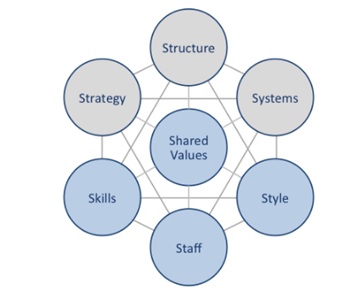
Figure 1: British Airways McKinsey’s 7S model
(Source: Ruiz-Pava and Forero-Pineda, 2018)
Hard Elements
Strategy: The British Airways makes use of the service differentiation as the Business strategy. The services of the firm are differentiated through extension reliance on digitalization and information technology and high standards of services customized.
Structure: The British Airways is a part of the International Airline Group (IAG) and the organizational structure of hierarchical as per the large size of the business with the CEO about to introduce de-layering as an attempt at cost-cutting measures.
Systems: The systems in place include the employee recruitment and selection system, performance appraisals system and they support customization through the quality control systems, complaint-handling system, etc (Perveen and Habib, 2018).
Soft Elements
Shared values: The British Airways shares the value towards enhancing the brand visibility through innovation, expertise and timeliness of the services offered.
Skills: The CRM units of the firm provide a detailed report of the skills and s competency levels through learning packages as a part of the on-job training (Widiyanto et al. 2017). However, a pertinent weakness of the firm lies in its overdependence on the UK Government or development of the skill.
Staff: A large diverse employee base with 45,000 employees worldwide is witnessed in the operations of the firm (Koopmans et al. 2016). This has facilitated the Airline to fly to more than a dozen of new routes in 2016.
Style: The Senior management at the firm believes in a collaborative and inclusive business style with the partnering firms and the subsidiaries by promoting inclusiveness at workplaces towards achieving the shared goals.
Product life cycle (PLC)
Considering the market position of the different services of the British Airways in the Airline industry in UK, the British Government is observed to be in the growth stage as the pricing policy of the British Airways is premium pricing policy and the reasonability of the costs are due to the economies of scale. In addition, the profitability is observed to be rising with the increase in competition (Policy, 2016). For instance, in the route New York, JFK - London (LHR/LGW/LHY), the main competitors include American Airways, Virgin Atlantic, Delta, etc.
Portfolio analysis (BCG Matrix)
|
Stars The long hauls have been the most profitable services of the firm This is in terms of generating more revenue through longs destination travel (Koopmans et al. 2016) |
Question Marks The growth of the venture of the Cargo has been doubtful Uncertainty in the cost-efficiency in low priced markets (Fozer et al. 2017) |
|
Cash Cows Low investment in the short haul services have elevated the profit margins This makes it a high grossing service |
Dogs The “Go” has been observed to have low growth rate in the markets This is due to the profitability of the routes it covered |
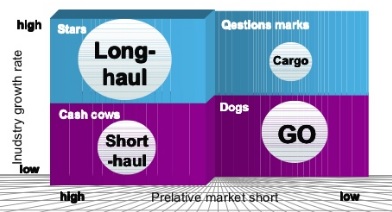
Figure 2: British Airways BCG Matrix
(Source: Koopmans et al. 2016)
Innovation and adoption curve
It may be reasonable to state that the British Airways are in their ‘Early Adoption’ stage of the innovation and adoption curve (Fozer et al. 2017). This has been the consequence post the analysis of the relative advantage of innovation, compatibility with the services of the airlines with the potential adopters’ (customers and employers) current ways and the complexity of the innovation.
Figure 2: British Airways Innovation and adoption curve
(Source: Koopmans et al. 2016)
Micro Environmental Analysis
Porter’s five competitive forces
Competitive Rivalry is observed to be HIGH considering the factors like high exit barriers, high industry concentration in the UK Airline industry, variable costs due to the deregulation of the crude oil prices by the UK government and low switching costs (Mizsey, 2017).
Supplier Bargaining Power is observed to be LOW due to increased partnerships, high Supplier concentration, and high differentiation of the inputs and the high threats of forwards integration in the company with subsidiary units of the British Airways (Fozer et al. 2017).
Customer Bargaining Power is observed to be MODERATE considering the partnerships that makes reasonable pricing of the tickets and increased in value and incentive creation for the customers (Mizsey, 2017).
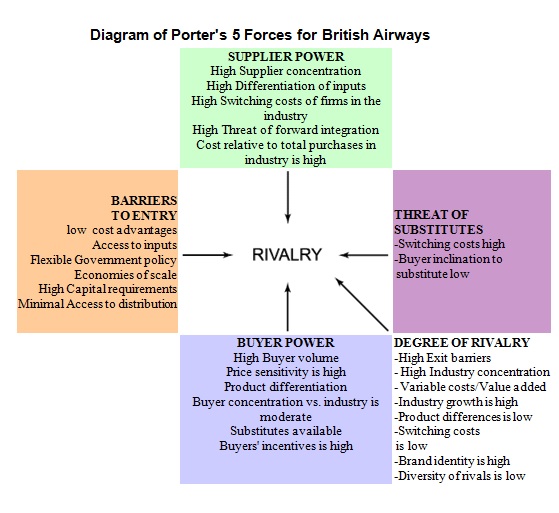
Figure 3: Porter’s five competitive forces for British Airways
(Source: self-developed)
Threats of Substitutes is LOW, as there is no substitute to Air travel in the current times. However, other modes of travel through roads and vehicles pose a threat to the short-haul services of the firm (Fozer et al. 2017).
Threats of New Entrants is LOW as an important barrier for the new entrance is the huge capital requirement and the lack of adequate distribution channels in the airline industry of UK (Mizsey, 2017).
Macro Environmental Analysis
|
Political A great amount of political imbalance is witnessed due to recent events like Brexit and devolution of the constitutional powers Terror attacks in 2005 had impacted the operations of the British Airways in UK significantly (Aithal, 2016) |
Economic The UK economy has still not recovered from the after effects of the GFC of 2008-2009 Rising oil prices and the rise in the labour costs will affect the flights demands of British Airways |
Socio-Demographic The social trends like the ageing of the flyers in UK will decrease the flight demands (Aithal, 2016) new trends of leisure travel and long-haul tourism will however, increase the demands of the firm |
|
Technological The R&D units of the British Airways are increasingly by the aid of the government The top quality flights used by BA are the result of increased investment in aviation engineering and therefore, the technological environment will facilitate the growth of the business in UK |
Legal Under the legal frameworks of UK the Airline licensing concerning with the operations and routes license is pertinent aspect to comply with (Policy, 2016) Additional legal obligations that will affect the operations of British Airways are the Equality Act 2010, Employment Act 2002, Companies Act 2006, etc |
Environmental The recent developments illustrates that different Airlines in UK have reduced the gas and strength consumption This is accomplished through improvements in aerodynamics towards the sustainable development of their business (Policy, 2016) This affects the operations of the British Airway towards establishing competitive advantage over other airlines through sustainable developments |
Reference List
Aithal, P.S., 2016. Assignment on ABCD analysis technique for business models, business strategies, operating concepts & business systems.
Britishairways.com. (2018). [online] Available at: https://www.britishairways.com/cms/global/microsites/ba_reports0910/pdfs/Strategy.pdf [Accessed 17 Jul. 2018].
Fozer, D., Sziraky, F.Z., Racz, L., Nagy, T., Tarjani, A.J., Toth, A.J., Haaz, E., Benko, T. and Mizsey, P., 2017. Life cycle, PESTLE and multi-criteria decision analysis of CCS process alternatives. Journal of Cleaner Production, 147, pp.75-85.
Koopmans, T., Crutzen, S., Menzen, M.H., Halayko, A.J., Hackett, T.L., Knight, D.A. and Gosens, R., 2016. Selective targeting of CREB‐binding protein/β‐catenin inhibits growth of and extracellular matrix remodelling by airway smooth muscle. British journal of pharmacology, 173(23), pp.3327-3341.
Perveen, S. and Habib, S.S., 2018. IDENTIFYING CONSTRAINTS FOR HOSPITAL INFECTION CONTROL MANAGEMENT VIA MCKINSEY 7S FRAMEWORK IN PAKISTAN. Pakistan Journal of Public Health, 7(4), pp.213-222.
Policy, P., 2016. What is pestle analysis.
Ruiz-Pava, G. and Forero-Pineda, C., 2018. Internal and external search strategies of innovative firms: the role of the target market. Journal of Knowledge Management.
Widiyanto, N., Hidayanto, A.N., Sandhyaduhita, P.I. and Budi, N.F.A., 2017, October. Social media strategy for government information services: A case of the ministry of education and culture in Indonesia. In Advanced Computer Science and Information Systems (ICACSIS), 2017 International Conference on (pp. 178-183). IEEE.
Zebal, M.A., 2018. The impact of internal and external market orientation on the performance of non-conventional Islamic financial institutions. Journal of Islamic Marketing, 9(1), pp.132-151.
TASK 2: Essay
SWOT analysis
Strengths
- Effective Global brand name and networking
- High profitability
- Competitive advantage through large size in terms of fleets
- Financial Superiority
- Effectual Management Skills
The above strengths illustrate the fact that the most important factor that adds to the strengths of the British Airways is its ability of effectively creating a brand name for itself (West, 2017). It is observed that the British Airways has been able to generate a great among of profitability through expanding the existing supplier reach by having a long-term collaboration with the Boeing and the recent expansion with suppliers like Airbus and Embraer (Grant, 2016). This has enabled the firm to accomplish routes expansion in terms of more than a dozen of new routes in 2016.
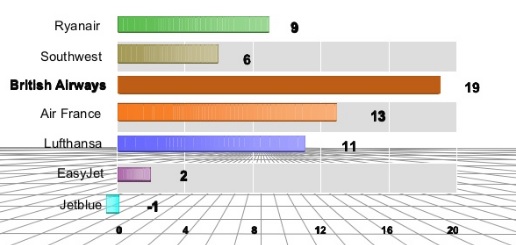
Figure 5: Profits per Passenger
(Source: Bull et al. 2016)
Weaknesses
- Aging of the passengers
- Nominal standards of customer services in the times of increased competition in the British markets
- Cost disadvantage
- Discontinuity of business strategies
As per the analysis of the operations of the firm, the average age of the fleet is observed to be 9.5 years that has risen from that of the previous 3 years with 2.5 years drastically. Therefore, there will be greater requirement for investing in infrastructure (Bull et al. 2016). In addition, the company has not been able to perform well in the cost control units and have frequently changed its business strategy without achieving the goals of the previous set strategies.
Opportunities
- Integration of the European markets
- Rising popularity of the Airways as a means of transport
- Growth of the Tourism Industry in UK
Post Globalization, the improvements in infrastructure has enabled growth in the Tourism and Hospitality Industry, which has been witnessed to be a great opportunity for the aviation industry in UK (Singh et al. 2016). For instance, the announcement by the British Airways for summer holiday routes like Florence, Ibiza, etc is a crucial illustration.
Threats
- Influx of new entrants in the fast growing aviation sector of UK
- Rise in competition from direct rivals (Grant, 2016)
- Threats of competitors flying in the same thoughts as that of British Airways
The primary threats are observed from the direct competitors of the firm who have their gleelst in the same routes as that of the British Airways such as Etihad Airways, Qatar Airways, Qantas Airways, Lufthansa, Emirates airline, etc (Grant, 2016).
New product or service idea for the company
The new service idea for the British Airways is the New Club World business class seats that will offer the with the direct aisle access for every individual flying in the first class section o0f the British Airways. In simpler terms, the seats will allow the passengers to undergo couch-like experiences and may rather be considered a ‘sofa’ instead of a seat (Shaw, 2016). The main purpose of this service would be to enhance travel experience of the passengers and additionally ease the experience of landing and taking-off by offering the opportunity to the aging passengers to stretch-out and relax.
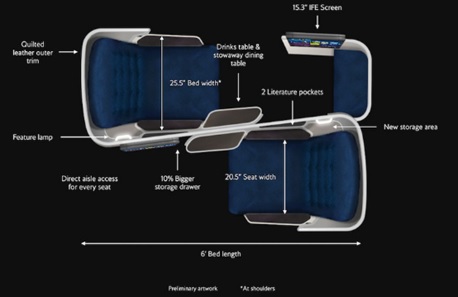
Figure 6: New Club World as the new service idea of the British Airways
(Source: Shaw, 2016)
Marketing objectives
Mission Statement
The mission statement of the British Airways is to become the world’s leading premium airline at a global level. The British Airways aims t continuing to focus on providing optimum levels of customer service at every level of passenger’s journey (Jarach, 2017). The main mission is to become world best in terms of latest equipments, products and services in aviation industry.
Corporate Objectives
The Corporate Objectives of the British Airways include the following:
- To become the airline of choice among the long-haul premium customers
- To deliver outstanding and unique services for customers at every touch-points
- To growth brand visibility by 10% in key Global cities through enhanced connectivity within the next three years (Britishairways.com, 2018)
- To maintain the market-leadership in London
- Improve cost margins and revenues increased in-flight sales and meet customer needs within the next three years
The marketing objectives of the
Marketing Objectives
- To offer better customer experience through the premium experiences in specific fleets like the Boeing 777 and 747s
- Top achieve the 10 % operating margin through economic cycles of the new service
- To achieve network punctuality along with premium services of the new service.
As per the analysis of the internal and external market trends, the marketing objectives have been developed keeping in mind the requirement of a strong financial performance in the next three financial years of the British Airways. In order to achieve the key objectives, it is pertinent to align the marketing objectives with the corporate objectives (Belobaba et al. 2015). For instance, the corporate objective of maintaining market position of the British Airway will only be facilitated with achieving the 10% operating margins of the new service.
Marketing strategies
Growth strategies
The growth strategy that has been incorporated for the development of the new se service of New Club World business class seats is the strategy of Product Development. Considering the novelty of the idea of New Club World business class seats, the development of such a product needs to take place in already existing market base of the firm in order to avoid the risks of failure of the product and exploit the established market (Kimes and Wirtz, 2015).
Competitor strategies
The competitor strategy that may be considered for the development of the New Club seats by Differentiation. The differentiation will allow a sustainable development of the new services and achieve competitive advantage and the increase in profit (Taneja, 2017). The rationale behind the competitor strategy rests with the fact that the market segment for the first class flying individuals is very small and thus, the differentiation will allow the necessary insight on competitors with less customized sales models.
STP strategies
Segmentation
The segmentation of the UK passenger base for the British Airways when accomplished in terms of Psychographic and the behavioural factors, the primary set of segments are observed to be very diverse. The behavioural segmentation divides the customers in segments of those who make travel decisions in airways depending on benefits offered, User status such as first timers and frequent flyers and the Attitude towards airways (Kimes and Wirtz, 2015). The Psychographic segmentation divides the customers into groups for those who plan their trips based on factors like regular tripping, recreational purpose, and business purpose or honeymoon trips.
Targeting
To increase the revenue gains and market share, the targeting decisions should be based on the following:
- Frequent flying and regular flying segments
- Market segments with neutral to positive attitude towards airways as a means of transport
- Market segments who are the travel short-haul travel destinations for purposes like recreational, business and other personal activities (Lawton, 2017)
Positioning
The positioning of the new services are aligned with the communication plans and the product development strategy (Williams, 2017). The positioning plan is illustrated in the sections below in details to convey the uniqueness of the new service with the help of the 7P marketing mix strategy.
Marketing tactics
Product
The new service are the New Club World business class seats that aim at offering the enhanced customer experience in the Assignment of their travel. The core USP of the service is its unconventional design in providing direct aisle experience, which has not been seen in any other aviation company in UK (Williams, 2017).
Actual Product
The actual product was first class seats in the form of static seats or recliners but with narrower space that initially offered limited space for the passengers towards relaxing in long-haul journeys.
Augmented Product
- With changing customer preferences, the elegant new seats aim at attracting 50% more customers in the first class range.
- New services in place with the prevailing ones, will increase the space available for the customers to relax in their journeys and allow more comfort that will ensure elevation in customer loyalty (Sheth, 2017)
Price
Considering the resource requirement of the products and the quality of the services, the pricing strategy adopted for the service in question is the premium pricing policy with a combination of penetration pricing and price skimming techniques.
Place
The placing generally refers to the distribution channel of the services. The primary distribution channels of the new services will be through dual distribution strategy with the utilization of both intermediaries and direct channels (Sheth, 2017). Direct channels include the Airports of the different destinations where the British Airways is operational along with the travel agents as intermediaries.
Promotion
The promotion strategies include both the traditional and digital promotional channels.
|
Objectives |
% Budget |
|
Differentiate |
c.45% |
|
Reinforce |
c.15% |
|
Persuade |
c.40% |
Media Strategy
The media strategies for communicating the USP and the purpose of the services can be accomplished through the strategies of push, pull and profile development strategies through different channels like newspaper, electronic media, magazines, radios, etc (Sheth, 2017).
Online promotion Strategy
The online promotional strategy involves the development of a customized website for just this product and the increased social media entries and posts of this new service on platforms like Facebook, Twitter, etc (Mayo et al. 2016).
Extended marketing mix
People involve the new graphic designers, aviation engineers and the ground and cabin staff who are at direct stake with the development of this new service.
Processes involve service delivery machineries at both the ground and cabin operational areas such as ticketing, catering, etc (Nagle and Müller, 2017).
Physical Evidences involve the Airport premises, presentation of cleanliness in the cabin and the ground areas near the aircrafts aim at attracting the customers.
Action plan
Task Allocation
|
Activity |
Rationale |
Time-scale |
|
Introduce new services of new business class seats on long haul targeting a customer base of 36,000 |
The rationale behind the target customer segment is to place the service initially among the small section and assess the profitability of the venture to avoid any potential financial risks. |
Weekly measure |
|
Accomplish restyled first class cabins in Boeing 777s and 747s from London City to New York JFK |
The rationale behind this is to assess the importance of the departure punctuality within the set out locations and promote the marketing tagline of ‘Ready To Go’ of the British Airways (Nagle and Müller, 2017). |
Weekly measure |
|
Accomplish marketing cost restructuring to achieve increased operational margin |
The rationale remains to be towards achieving the operational robustness and the corresponding cost-effectiveness of the service and noting the different possible disruptions that can affect the operational efficiency of the service |
Weekly measure |
The Gantt chart for the tasks in illustrated in figure 6.
Figure 6: gantt chart for the tasks
(Source: Self-developed)
Budget
|
Elements |
2018 (in £) |
2019 (in £) |
2020 (in £) |
|
Market Research and Analysis |
5400 |
5760 |
6760 |
|
Human Resource |
38,700 |
42,300 |
45,300 |
|
Sponsorship |
78,000 |
81,900 |
85,900 |
|
Processes |
15,600 |
18,910 |
12,910 |
|
Website Activities |
23,000 |
25,000 |
25,000 |
|
Traditional Promotions |
2,22,000 |
3,15,000 |
3,20,000 |
|
Staffing |
7500 |
9000 |
9000 |
|
Total |
3.90,200 |
4,97,870 |
5,04,870 |
Control
The control section of plan is associated with the monitoring of the outcomes of the implementation of the marketing plan. The most significant performance indicator that should be taken into account is the customer recommendation KPI, Operating margin and Network punctuality. Apart from these the fundamental Performance measures are illustrated in the table below
|
Perspective |
Objectives |
Measure |
|
Financial Perspective KPI |
- Increase revenue - Increase market share and sales |
- Annual financial reports - Total sales margins |
|
Customer Perspective KPI |
- Improve Customer experience in leisure travels |
- Increased customer loyalty - Increased fleets numbers |
|
Innovation and Learning KPI |
- Improve employment product and service knowledge (Wang, 2014) - Improve the R&D units of the firm |
- Increase in the percentage of trained employees - Increased patents |
Conclusion
By the means of this assignment, an attempt had been made at adjoining the fundamental principles and factors of the marketing environment of the British Airways and the situational analysis for the firm pertinent to develop the marketing plan for the flag carrier (Sze et al. 2015).
Additionally, it may be reasonable to conclude that the new service of the British Airways is aimed at generating profitability and establish competitive advantage of the firm over the others.
Reference List
Belobaba, P., Odoni, A. and Barnhart, C. eds., 2015. The global airline industry. John Wiley & Sons.
Britishairways.com. (2018). [online] Available at: https://www.britishairways.com/cms/global/microsites/ba_reports0910/pdfs/Strategy.pdf [Accessed 17 Jul. 2018].
Bull, J.W., Jobstvogt, N., Böhnke-Henrichs, A., Mascarenhas, A., Sitas, N., Baulcomb, C., Lambini, C.K., Rawlins, M., Baral, H., Zähringer, J. and Carter-Silk, E., 2016. Strengths, Weaknesses, Opportunities and Threats: A SWOT analysis of the ecosystem services framework. Ecosystem Services, 17, pp.99-111.
Grant, R.M., 2016. Contemporary strategy analysis: Text and cases edition. John Wiley & Sons.
Jarach, D., 2017. Airport marketing: Strategies to cope with the new millennium environment. Routledge.
Kimes, S.E. and Wirtz, J., 2015. Revenue management: Advanced strategies and tools to enhance firm profitability. Foundations and Trends® in Marketing, 8(1), pp.1-68.
Lawton, T.C., 2017. Cleared for take-off: structure and strategy in the low fare airline business. Routledge.
Mayo, A., Nohria, N. and Rennella, M., 2016. Entrepreneurs, managers, and leaders: What the airline industry can teach us about leadership. Springer.
Nagle, T.T. and Müller, G., 2017. The strategy and tactics of pricing: A guide to growing more profitably. Routledge.
Shaw, S., 2016. Airline marketing and management. Routledge.
Sheth, J., 2017. Revitalizing relationship marketing. Journal of Services Marketing, 31(1), pp.6-10.
Singh, M.K., Kumar, H., Gupta, M.P. and Madaan, J., 2018. A Glimpse of Sustainable Electronics Manufacturing for India: A Assignment Using PEST-SWOT Analysis. In Global Value Chains, Flexibility and Sustainability (pp. 271-281). Springer, Singapore.
Sze, C.M., In, L.W., Ngai, L. and Yan, O.W., 2015. Budget Airline Industry in Hong Kong. International Journal of Trade, Economics and Finance, 6(2), p.129.
Taneja, N.K., 2017. Driving airline business strategies through emerging technology. Routledge.
Wang, S.W., 2014. The moderating effects of involvement with respect to customer relationship management of the airline sector. Journal of Air Transport Management, 35, pp.57-63.
West, D., 2017. Project Sponsorship: An Essential Guide for Those Sponsoring Projects Within Their Organizations. Routledge.
Williams, G., 2017. The airline industry and the impact of deregulation. Routledge.


